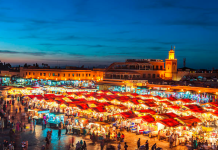A tourist enjoys the view of Mayon Volcano from Sumlang Lake in Camalig, Albay. — PHILIPPINE STAR/ EDD GUMBAN
THE PHILIPPINES ranked 37th out of 138 destinations in the latest report that measures a country’s preparedness in tapping the Muslim travel market.
The Mastercard-CrescentRating Global Muslim Travel Index (GMTI) 2022 report showed the Philippines had an overall score of 43.
The score is based on four key areas — ease of access to the destination, internal and external communication, environment, and services.
“As the travel industry gears up for quarantine-free international travel, we believe the Muslim travel sector could contribute immensely to accelerating the recovery,” Fazal Bahardeen, founder and CEO of CrescentRating, said in the report.
In the previous year’s report, the Philippines ranked 36th out of 140 destinations with an overall score of 46.
Malaysia topped this year’s travel index, followed by Turkey, Saudi Arabia, and Indonesia. A total of 138 countries were ranked in 2022, down from 140 countries included last year, after Russia and Ukraine were excluded due to the war.
Under the access criteria for 2022, the Philippines scored 83 for visa requirements, 21 for connectivity, and 57 for transport infrastructure. In terms of communications, the country scored 54 for destination marketing, 41 for communication proficiency, and 30 for stakeholder awareness.
Under environment, the Philippines had 61 for safety, 100 for faith restrictions, 3 for visitor arrivals, 38 for enabling climate, and 30 for sustainability.
For services, the Philippines scored 47 for core needs such as halal food, 50 for prayer facilities, 40 for core services such as airports, 32 for hotels, and 10 for unique experiences.
This year’s index also showed that the Philippines remained on 8th place among the top 20 non-Organization of Islamic Countries (OIC).
Mr. Bahardeen said Muslim traveler arrivals are projected to reach 140 million in 2023 and 260 million in 2024.
“The pre-pandemic projection of 230 million arrivals by 2026 will now be reached in 2028 with an estimated expenditure of $225 billion. This recovery process is fragile and could be disrupted by the continuing war in Ukraine, fuel price increases, and other health threats such as the emerging monkeypox or coronavirus disease 2019 (COVID-19) variants,” Mr. Bahardeen said.
In a separate report, the United Nations World Tourism Organization (UNWTO) said that the recovery of global tourism is now gaining momentum after the easing of restrictions and increase in tourist arrivals.
Based on the UNWTO’s latest World Tourism Barometer, international tourism rose by 182% year on year in the first quarter of 2022, after recording 117 million international arrivals from 41 million in the same period last year.
“Of the extra 76 million international arrivals for the first three months, about 47 million were recorded in March, showing that the recovery is gathering pace,” the UNWTO said.
“Although international tourism remains 61% below 2019 levels, the gradual recovery is expected to continue throughout 2022, as more destinations ease or lift travel restrictions and pent-up demand is unleashed,” it added.
However, the UNWTO noted that the Ukraine-Russia conflict poses a risk to the recovery of international tourism.
“The Russian offensive on Ukraine seems to have had a limited direct impact on overall results so far, although it is disrupting travel in Eastern Europe. However, the conflict is having major economic repercussions globally, exacerbating already high oil prices and overall inflation and disrupting international supply chains, which results in higher transport and accommodation costs for the tourism sector,” the UNTWO said.
International tourist arrivals are expected to hit up to 70% of 2019 level this year, it added. — Revin Mikhael D. Ochave













